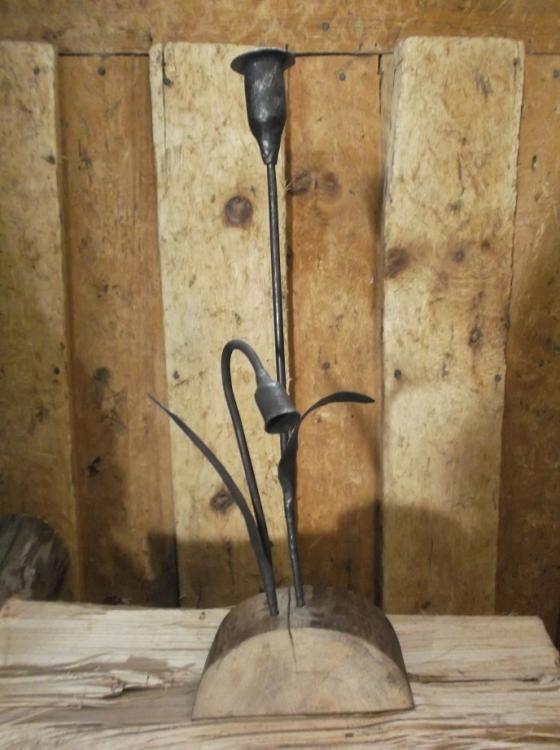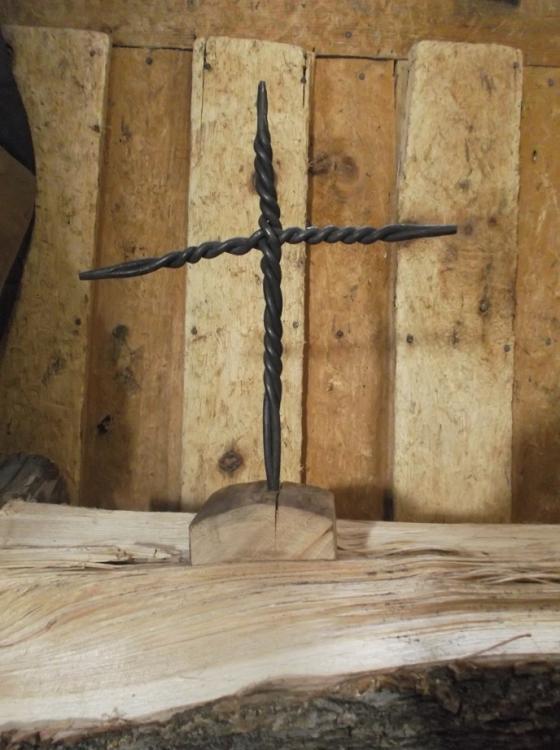
Iron Poet
Members-
Posts
180 -
Joined
-
Last visited
Content Type
Profiles
Forums
Articles
Gallery
Downloads
Events
Everything posted by Iron Poet
-
I've made bolts and nuts before. It's not hard, but there is absolutely zero profit in it unless you are doing something quite weird.
-
Does anyone do hammer and chisel engraving?
Iron Poet replied to Glenn's topic in Blacksmithing, General Discussion
I think that it's a jeweler's vise. -
How to form a 'cone'
Iron Poet replied to Jonathan Snell's topic in Spears, Arrows, Pole arms, Mace/hammer etc.
I'll add this, I personally believe it would be easier to forge weld the material for the cone to the spear point than forging the cone out of a single piece. trying to forge a cone out of 1" material is not fun. -
44 ft Railing project..... dang near the death of me.
Iron Poet replied to David Kailey's topic in Member Projects
I know that in Canada the restrictions are very severe and I'm pretty sure his nice railing wouldn't pass muster. For instance fences need to be completely straight and without footholds for the first 4 or 5 feet. I think interior railings also have similar stipulations as children could climb up the railing and crack their skulls open. But, if someone can afford 44 feet of custom ironwork, they can probably slip the building inspector a bribe as well.- 15 replies
-
- butterflies
- beatles
- (and 4 more)
-
This may have been said in the 10 years this thread has been up. But what I do is I put borox in between the joints before I fit them together. This way it doesn't foam up and off and instead forms a nice even layer. I see very little sense in trying to force the flux into a tiny crack when it should be there in the first place.
-
I made mine out of 1/4" mild steel. In the 2 years since I've been using it I haven't noticed any degradation at all.
-
What did you do in the shop today?
Iron Poet replied to Mark Ling's topic in Blacksmithing, General Discussion
Measure out the material to the needed length then bend it to a 90 degree angle. Weld a 1/2" rod to a flat piece of plate, put both the fork end and the jig into a vise. That way you can hammer the eye halfway around a circular template which makes finishing the ring around a 1/2" drift much neater. I do something very similar for hinges. -
What did you do in the shop today?
Iron Poet replied to Mark Ling's topic in Blacksmithing, General Discussion
Ya don't say -
I don't want to seem like a Jerk, but I wouldn't waste a nice piece of 1/2" 1080 on that, especially if it's a foot or so long and an inch or two wide.
-
No one wants an anvil horn in their crotch. I speak from experience.
-
Musket trigger guard material
Iron Poet replied to Jonathan Snell's topic in Gunsmithing, Muskets, Flintlocks etc
I find that phosphorus bronze, the kind commonly used for casting works great. Another problem is that you need excellent hammer control due to bronze being incredibly soft at forging temperatures, almost like hitting wet clay. -
Musket trigger guard material
Iron Poet replied to Jonathan Snell's topic in Gunsmithing, Muskets, Flintlocks etc
You can forge bronze into whatever shape you want. I'll warn you that bronze is a bit touchy as being forged and if you're inattentive for a second it will either crumble into cottage cheese or just melt. -
NIMBAs are really good. I actually learned how to blacksmith on one, I can't think of anything wrong with them other than how LOUD they are and that they might be a teeny bit soft. Actually getting one might be a bit hard though, when I was anvil shopping they wouldn't return any of my Emails. I'd suggest you also look at these http://www.hoffmansforge.com/my-work/anvils/ They're very similar in shape to NIMBAs but are squatter and a little less expensive.
-
What did you do in the shop today?
Iron Poet replied to Mark Ling's topic in Blacksmithing, General Discussion
I think having a couple unpaid interns to do all the grunt work would be funner, but that's just me. I am trying to trick one of the local colleges into doing just that, so far none have taken the bait. -
What did you do in the shop today?
Iron Poet replied to Mark Ling's topic in Blacksmithing, General Discussion
I'll probably show more if I don't forget about it. The trick to fitting everything together before you forge weld, bending the leaves so they snuggly grip the stem, or making sure the cups have enough material to grab the stem properly. I unfortunately work by myself so I've had to slowly develop techniques to do stuff like this with only two hands. If you do open the shop back up don't be afraid of trying to forge weld some plants together, sheet metal is a little finicky but it is totally possible and it looks much better than electrically welding them on. -
What did you do in the shop today?
Iron Poet replied to Mark Ling's topic in Blacksmithing, General Discussion
The key to creativity is laziness. I realized that the small flowers I made didn't fit the candles I bought so I turned them into snuffers since it was less work than enlarging the cups. But it's all just practice, I plan on making more elaborate flowers after I get comfortable with forge-welding sheet metal. -
What did you do in the shop today?
Iron Poet replied to Mark Ling's topic in Blacksmithing, General Discussion
I worked my design a little bit and made my previous candlestick into a snuffer while I made a larger one to go with it. I also made a forge-welded cross, twisting it was a huge pain though probably because I cheaped out and only used two rods for the bar -
Flower Candle Holders - thin forge welding practice
Iron Poet replied to Iron Poet's topic in Member Projects
For thin stock there will be almost no sparks since you're dealing with far less material. You just need a few sprinkles of borax and a very keen eye on your air flow, you should be able to maintain forge-welding temperature without accidentally straying to hot. Pre-forming the pieces so that they come together easier is also a must, what I did with the leaf is that I curved a 1/2" into a C-shape so that it would easily stay on. -
Flower Candle Holders - thin forge welding practice
Iron Poet replied to Iron Poet's topic in Member Projects
It's not hard at all trust me on this. You just flux it, put it in the fire, watch it turn bright yellow, and then tap it with a hammer. I didn't even make a cave to forge weld these I just stuck them in the coal. I think the majority of people just psych themselves out and over think the process, a little confidence helps ya know? Besides even if you mess up it's not like it's going to cost you more than a quarter or for you aussies 1/512th of a keg of Fosters -
Looking for a good anvil
Iron Poet replied to Paint504's topic in Anvils, Swage Blocks, and Mandrels
You could look over at Old World Anvils. you can buy a small stake anvil and a fuller for $50 If you're only going to make knives you won't need much more than that. If it's good enough for the vikings it's probably good enough for you! Of course you could always save your pennies are buy something more substantial. -
What did you do in the shop today?
Iron Poet replied to Mark Ling's topic in Blacksmithing, General Discussion
-
These are made of 1/2" pipe for the cups, 1/4" for the stems, and 1/16" for the leaves. Everything was put together in a pretty sloppy manner, but the welds are nice and solid. I did these because someone wanted candle holders and because I want to make some cattails and figured this was a good proof of concept. Feel free to critique
-
Dumb Question re Rust
Iron Poet replied to Jonathan Snell's topic in Blacksmithing, General Discussion
Get them hot, dip them in oil. -
If only you knew a blacksmith that would be able to make you a pair of tongs to fit your exact needs

